Owls
Across the world there are over 200 different species of owls, from the tiny Pygmy Owl to the statuesque European Eagle Owl.
Owls are generally considered to be nocturnal hunters, however they are actually quite capable diurnal hunters with some species even preferring to hunt during the day. Gauntlet is home to 13 different species of Owl plus our very special hybrid owl (a cross between a Malaysian Wood Owl and a Great Grey Owl). These silent hunters can be seen during our daily demonstrations and our special evening events like Owls by Moonlight and An Evening with Owls and Friends!
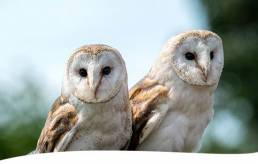
Barn Owl
Often referred to as “The Ghost Owl”, because when they fly through the dark night sky their white figure makes them look like a ghost!
LATIN NAME: Tyto alba
DISTRIBUTION: Worldwide
HABITAT: Open lowland, farmland, semi-arid shrubland, marshes
DIET: Small mammals
WINGSPAN: 85–95cm
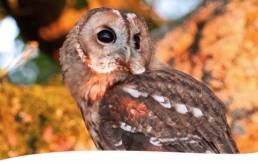
Tawny Owl
The “twit-twoo” sound you hear an owl make is actually two individual sounds – one is the sound of a male and the other a female.
LATIN NAME: Strix aluco
DISTRIBUTION: Europe, parts of Asia and North Africa
HABITAT: Mainly woodland
DIET: Varied. Small mammals, young nest bound birds, invertebrates
WINGSPAN: 95–105cm
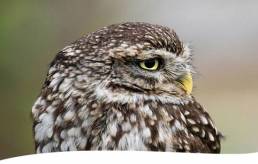
Little Owl
Mainly nocturnal but can be found in the day hunting small mammals and foraging for other small things like worms.
LATIN NAME: Athene noctua
DISTRIBUTION: Europe
HABITAT: Open country, they tend to avoid dense woodland and forest
DIET: Mainly insects
WINGSPAN: 54–58cm

Long-eared Owl
The feathers on top of this owls head are not its ears, they are just feathered tuffs. An owl’s ears are actually located on their facial disk.
LATIN NAME: Asio otus
DISTRIBUTION: North America, Europe, North Africa
HABITAT: Wooded areas, forest edges, hedgerows
DIET: Small rodents, occasionally small birds
WINGSPAN: 25–32cm

European Eagle Owl
The largest species of owls found in the world.
LATIN NAME: Bubo bubo
DISTRIBUTION: Europe, Western Russia
HABITAT: Open woodland
DIET: Mammals – typically rabbit and hare, has also been known to take foxes and roe deer
WINGSPAN: 160–190cm
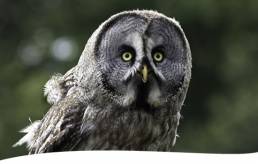
Great Grey Owl
The Great Grey Owl has over 3000 feathers on its body.
LATIN NAME: Strix nebulosa
DISTRIBUTION: North America, Northern Asia, parts of Scandinavia
HABITAT: Mix of dense forest and open areas
DIET: Mainly small mammals including voles, gophers and mice
WINGSPAN: 140–150cm
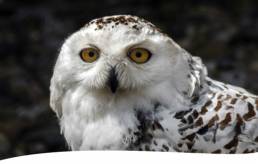
Snowy Owl
Snowy Owls nests are called ‘scrapes’ and are found on the ground. Chicks are covered in grey feathers when young so that predators mistake them for rocks.
LATIN NAME: Nyctea scandiaca
DISTRIBUTION: Arctic tundra of North America, Europe and Asia
HABITAT: Arctic tundra, open grassland and prairie, coast
DIET: Mammals and birds including lemmings, rabbit, voles, ptarmigan, sea birds and geese
WINGSPAN: 140–165cm

Great Horned Owl
The Great Horned Owl was known as the ‘winged Tiger’ or ‘Tiger of the air’.
LATIN NAME: Bubo virginianus
DISTRIBUTION: North and South America
HABITAT: Varied
DIET: Small to medium sized mammals, some birds
WINGSPAN: 100–150cm

Burrowing Owl
Burrowing Owls live in burrows (hence the name) on the ground that have been left by other animals like prairie dogs.
LATIN NAME: Athene cunicularia
DISTRIBUTION: Mid-America to South America
HABITAT: Grassland
DIET: Small animals and insects
WINGSPAN: 51–61cm

Milky Eagle Owl
Milky Eagle Owls are also known as the “giant eagle owl” or “vicious eagle owl” in Africa.
LATIN NAME: Bubo lacteus
DISTRIBUTION: Sub-Saharan Africa
HABITAT: Lightly wooded country
DIET: Medium sized mammals around the size of a hare and some birds
WINGSPAN: 160–190cm
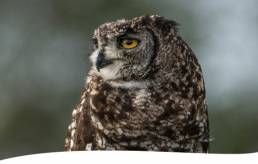
African Spotted Eagle Owl
African Spotted Eagle Owls nest on the ground and usually have up to 3 babies.
LATIN NAME: Bubo africanus
DISTRIBUTION: Sub-Saharan Africa
HABITAT: Semi open woodland, scrub, savannah
DIET: Mainly large insects, occasionally small mammals and birds
WINGSPAN: 100–140cm

Chaco Owl
Found around the Gran Chaco region of South America.
LATIN NAME: Strix chacoensis
DISTRIBUTION: Southern Bolivia, western Paraguay and northern Argentina
HABITAT: Dry chaco woodland
DIET: Mainly small birds and mammals, also insects, spiders and scorpions
WINGSPAN: 65 –75cm
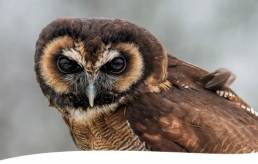
Malaysian Wood Owl
These owls are known to hang around shallow brooks and streams and hunt small fish.
LATIN NAME: Strix leptogrammica
DISTRIBUTION: India, south-east Asia
HABITAT: Forests and woodland
DIET: Small mammals and birds, also insects and fish
WINGSPAN: 105–115cm

